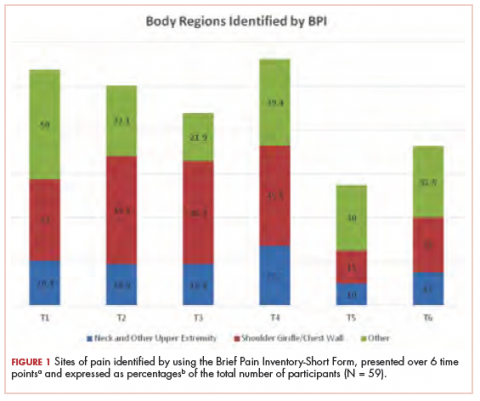The long-term effects of posttreatment exercise on pain in young women with breast cancer

Background Persistent pain after treatment has been identified in breast cancer populations, with prevalence rates ranging from 25%-60%. Age, surgical procedure, axillary node dissection, and radiation therapy have shown correlation with chronic pain development.
Objective To conduct a pilot randomized controlled trial targeting young breast cancer patients to determine the effectiveness of a 12-week exercise program on long-term levels of upper-limb pain, as measured by the Brief Pain Inventory-Short Form (BPI-SF), and pain measured by physical examination of specific shoulder movements.
Methods Young adults (18-45 years of age) recently diagnosed with breast cancer consenting to participate in this study were randomly allocated to intervention or control groups. The exercise intervention group participated in a 12-week exercise program starting 3-4 weeks after the cessation of radiation therapy, and the control group received standard care consisting of encouragement for an active lifestyle and pamphlets on the benefits of exercise. The location and severity of pain and its interference with daily life were recorded at the following 6 time points: postsurgery and preradiation (T1, baseline), postradiation and preintervention (T2), and 4 points during an 18-month period postradiation (T3-T6 at 3, 6, 12, and 18 months). In addition, clinical physical assessment of range of motion and pain on active shoulder movements were recorded at each time point.
Results 59 young breast cancer patients participated in the study (exercise group: n = 29; control group: n = 30). Over the course of the trial, there were no significant differences between study groups in the BPI-SF measures of pain interference and severity scores. Improvements in pain on shoulder movements were noted in the intervention group at 3 and 6 months postintervention (T3 and T4) but were not sustained over time (by T6, 18 months postradiation). Shoulder girdle-chest wall pain improved at 12 and 18 months postradiation in both groups but persisted despite exercise intervention. Recordings of shoulder pain on physical examination of range showed a distinct pattern of temporal improvement (T3-T5), followed by low levels of pain recurrence at 18 months postradiation (T6) in both groups.
Limitations Stringent exclusion criteria, including the absence of any shoulder pathology or pre-existent medical comorbidities impacting upper limb function, long-term follow-up, and the relatively small population of breast cancer patients in this age demographic, limited and prolonged recruitment for this study. In addition, the general activity levels of the young breast cancer survivors who agreed to participate in this exercise intervention study may have had an impact on the significance of results.
Conclusion Transient improvements in shoulder pain can be attributed to a 12-week exercise program, but they did not translate to long-term benefits. Moreover, the BPI-SF did not capture shoulder pain and limitations related to upper-limb disability in this study, in contrast with the findings on physical examination.
Funding This study was funded by Hope & Cope, a grant from the CURE Foundation, and grants from the Jewish General Hospital's Weekend to End Breast Cancer.
Accepted for publication May 15, 2018
Correspondence Mary-Ann Dalzell, MScxPT; madalzell5@gmail.com
Disclosures Thierry Muanza holds an intellectual property patent (United States Provisional Patent Application No. 62/359,918; Title: Adipose Mesenchymal Stromal Cells for Treating Radiation-Induced Oral Mucositis). Mary-Ann Dalzell, Richard Dalfen, Beatrice Fournier, Marize Ibrahim, Petr Kavan, Michael Palumbo, Warren Sateren, and Nadia Smirnow report no disclosures or conflicts of interest.
Citation JCSO 2018;16(3):e145-e151
©2018 Frontline Medical Communications
doi https://doi.org/10.12788/jcso.0395
Related articles
Measurement of physical activity and sedentary behavior in breast cancer survivors
Effects of exercise interventions during different treatments in breast cancer
Submit a paper here
More specific objective assessments of pain on active shoulder movement identified distinct patterns of pain that could not be isolated using the BPI-SF alone. The incidence and localization of pain on movement differed between the population of women who received a specific exercise intervention and those who received standard care (Figure 2). Patterns of pain over time fluctuated in the control group, whereas the intervention group reported a linear decrease in pain. Residual pain on shoulder movement remained apparent in both groups at 18-months postradiation, but that finding was not reflected in the BPI-SF results. The literature supports our findings on persistent pain among breast cancer survivors,3,7,8,28-30 and in our study of young women carefully screened and excluded for pre-existent shoulder conditions or comorbid medical conditions, recurrent articular pain was nonetheless prevalent. It seems that unidentified or multiple factors may be part of the etiology of pain in this young adult cohort.
Although the BPI-SF is a generic measurement tool commonly used to assess and measure cancer patients’ pain levels, the lack of variance in our BPI-SF severity and interference outcomes over time (T1-T6) (Table 1, Table 2), the variety of “other” unrelated regions (Figure 1) identified by the BPI-SF, and the contrast in our findings on specific physical examination emphasize the potential limitations of this clinical tool.
Moreover, the BPI-SF has not been validated specifically for breast cancer. Harrington and colleagues have recommended using the BPI-SF to assess pain in women with breast cancer,31 but the use of a more multidimensional measurement tool that evaluates axillary, chest, trunk, and upper-limb pain may prove to be more valuable in this population.
Limitations
Recruitment of young adult women was difficult because of our stringent inclusion criteria, the long-term follow-up, and the relatively small population of breast cancer patients in this age demographic. Therefore, the duration of the recruitment phase, despite our having access to a specialized young adult and adolescent clinic in our institute, greatly surpassed the expectations we had when we designed the study. In addition, there remains an inherent bias in participants who accept participation in a study that includes exercise interventions. Potential participants who exercise regularly or have a positive inclination toward doing exercise are more likely to participate. Despite the prescription of a targeted 12-week upper-limb intervention in this study, the general activity levels of both groups may have had an impact on the significance of this study. In addition, the low adherence to the use of self-reported logs failed to capture the true compliance rates of our participants because their lack of tracking does not indicate failure to comply with the program. The use of weekly or biweekly telephone calls to monitor compliance rates of activity more vigilantly may be used in future studies.
Conclusions
Advances in clinical management of breast cancer have improved survival outcomes, and morbidity over recent years, yet symptoms such as pain remain prevalent in this population. The results of this study showed that a targeted, 12-week upper-limb exercise intervention postradiation transiently improved levels of shoulder pain without a concomitant impact on chronic pain or any positive influence on activities of daily living 18 months posttreatment. Furthermore, future studies should use a variety of measurement tools to evaluate trunk and upper-limb pain in women with breast cancer and investigate the optimal timing of postradiation exercise interventions.
Acknowledgments
The authors thank Hope & Cope, the CURE foundation, and the Jewish General Hospital Foundation/Weekend to End Breast Cancer for providing the financial resources needed to sustain this research study. They also thank the McGill Adolescent and Young Adult program for its continued support. Previous oral presentations of research Muanza TM, et al. Randomized clinical trial of a progressive exercise program for young women with breast cancer undergoing radiation therapy. Int J Radiat Oncol Biol Phys. 2015;93(3):s35-s36.







